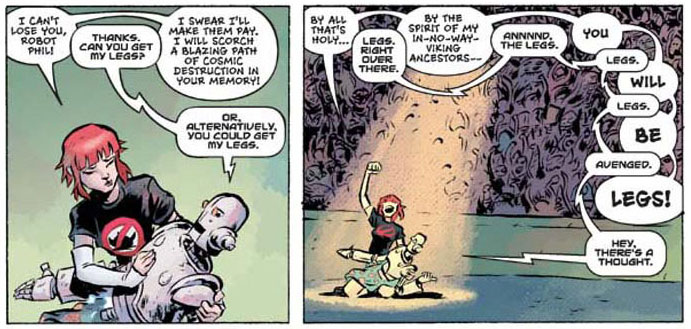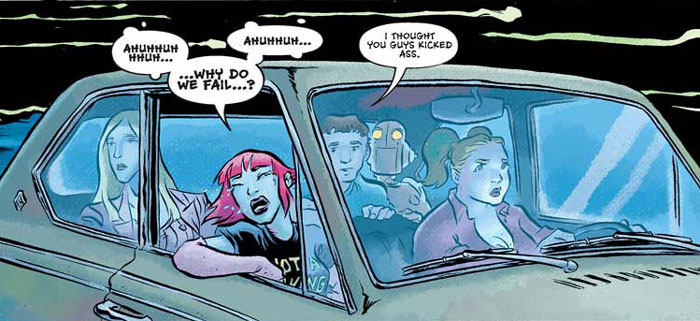I realize that I’m treading a potentially dangerous, career-killing line here. Joss Whedon fans are a rabid and devoted bunch who enshrine his creative output like they were gold-plated tomes of sacred literature. Dare I say one bad thing about the SugarShock! webcomic? Should I risk the possibility of being mobbed on the streets by rabid Browncoats in ill-fitting Firefly t-shirts, ready to defend the honor of their beloved lord and master to the very death? (For the record, I wasn’t too enamored of the Firefly TV show, but, overlooking some problems I had with some of the cutesy dialogue, I rather enjoyed the Serenity movie. The first person who mentions that Fox screwed it up and I should go watch Firefly in the right order earns my withering scorn … and my EVIL EYE.)
However, I’ll gladly brave the cruel slings and arrows of the Whedon fanboys and fangirls, because, without even reading the comic, I feel confident in my bold prediction that SugarShock! is the front-runner for 2008’s Eisner Award for Best Digital Comic.
Look for no further proof than 2007’s winner: Steve Purcell’s Sam & Max comic. Don’t get me wrong… I love that big old detective dog and his psychotic bunny pal. Playing "Hit the Road" is one of the most cherished memories of my youth. But the webcomic was all of 12 pages long and featured a story that was rather trite and mediocre. Award material? Most definitely not.
This was all the evidence I needed to indict Eisner Award judges as insular old nabobs who couldn’t really be bothered to read webcomics, dismissing them as passing fads generated by hyperactive 12-year-olds making sprite or stick-figure comics, and constantly pooh-poohing how anyone can make any money online for something you can give for free. (Hello, Ted Rall!) However, I’m going to make a wild guess that each and every one of those judges knows the name of Joss Whedon. They might even own both the complete Buffy and Firefly DVD sets. I also imagine they’ve spent time in their parents’ cellars downloading pictures of Sarah Michelle Gellar.

SugarShock! is brought to you by Dark Horse Comics, publisher of celebrated fare with names like 300, Hellboy, and, um, Barb Wire. The story spans the first three issues of the Dark Horse Presents (DHP) anthology title, which, historically, has been Dark Horse’s flagship book. Although the print run came to an end in 2000, DHP was brought back in 2007 as an online digital comic series. I heartily applaud the move. I’ve had my qualms with online anthology series in the past, but, the way Dark Horse is implementing it, the concept makes a lot of sense. Anthologies are typically filled with mainly unproven or disposable short stories, and they exist primarily to give new comic book writers and artists a little bit of exposure. Consequently, they’re hardly the sort of books that fly off the comic store’s shelves. Fortunately, DHP is one of the few anthologies with an excellent track record: it was responsible for the launch of both Paul Chadwick’s highly acclaimed Concrete series and Frank Miller’s brutally violent Sin City.
The DHP site is more visually pleasing than DC’s similar webcomic experiment, Zuda Comics. Although pages are presented through the much hated Flash interface (boo!), the layout lets the reader view the pages at a fairly comfortable size. For the first time, I could see the aesthetic benefits for using Flash. Fabio Moon’s art is fine, and it fits the comedic tone of Whedon’s writing, but it’s somewhat workmanlike and won’t set avant-garde tongues a waggin’. However, in Flash, the artwork looked crisper and more detailed than comparable webcomic art saved in .png or .jpg formats. It’s like the difference between newsprint and glossy paper. As another benefit, there was no lag time when clicking from one page to the next. I had one complaint, though: the sliding navigation screen at the bottom of the page — where you have to mouse over the left and right arrows — was a bit of a pain to use, causing me to overshoot the issue I wanted to read more than a few times.
For some utterly baffling reason, DHP is hosted on MySpace. Dear God … why? Unlike Zuda, which distances itself from its parent company, everything at the DHP site is branded with the Dark Horse imprint. Why wouldn’t they just host the comic at the Dark Horse site? I suspect words like "corporate synergy" and "targeted market distribution" were bandied about at Dark Horse central. Whatever. MySpace is cheesy, and seeing that name in the address bar was hella ghetto.
"That’s all well and good, El Santo," you no doubt are saying right now, "but what about the story. The story! Will SugarShock! send me into a grand mal diabetic coma like the name implies? Exclamation mark and all?"

SugarShock! is set in a world that’s part modern day, part science fiction, all rock and roll. We follow an all-girl band (or rather, mostly all-girl band) by the name of SugarShock! The group consists of hyperactive lead singer Dandelion, her two more reasonable bandmates Wade (the fat one) and L’Lihdra (the tall butch one), a robot named Phil, and a groupie. After losing a battle of the bands to Sensitive Guy, the band’s coupe gets totalled by a falling Gwar-esque alien. Dandelion sees this as a sign: a new gig awaits … in the stars! The band piles into spaceship, and they rocket off to another exciting adventure! Or, more precisely, an alien world where they have to fight to the death, reveal long-buried cosmic secrets, and change the universe through the power of rock like they were Tenacious D or something. That sort of thing.
SugarShock! is a short webcomic. If the pages were removed from the anothology and printed in a separate collection, you’d have enough for about one comic book. So, basically, it’s a one-shot. Believe me, I’m not complaining. I thought that Whedon’s Astonishing X-Men, while frequently delightful, tends to be ridiculously drawn out for what little plot it has. The shorter, more condensed storytelling in SugarShock! was not only more efficient, but it did a better job of highlighting the most magnetic aspects of Whedon’s trademark style… things like witty banter, shocking and humorous reversal of expectations, and strong female characters who actually act like women and not men in disguise.
I assume the series was so named because Whedon was on a monster Krispy Kreme bender when he was writing this story. I refuse to believe that the story was anything other than sugar fueled. In issue 1, Dandelion spends half her time hating on Vikings. That’s at least a Level 3 sugar rush. And there’s a totally non sequitur rant on Abraham Lincoln in issue 2 that rates a Level 5. I don’t know how the frolicking squirrels in issue 3 rate, but I imagine they were influenced by mounds and mounds of delicious, super-refined sugar. In case you haven’t caught on yet, SugarShock! is primarily comedic. I mean, it’s about rock stars and alien warriors and robots and bikers — it pretty much has to be. Thematically, SugarShock! reminds me a lot of The Adventures of Dr. McNinja, where ridiculous random elements were thrown around to form a similarly absurd story.
At the same time, Whedon does not whiff on the storytelling and character development. It would have been fairly easy for a busy guy like Whedon to simply stamp his name on a comic book and then hack out some utterly lazy tripe. (Is that your ears turning red, Kevin Smith?) How about when the product in question is a short webcomic buried within an anthology? But Whedon, classy guy that he is, does not ever sell his fans short.

Take the tender loving care that went into writing the character of Dandelion, for example. She’s the sort of obnoxious, bouncy ADD-addled chick that’s supposed to remind readers of their cute little sister, but, most of the time, reminds you of the little sister you wanted to abandon at the supermarket. She bawls over tiny slights, generally acts on emotion, and annoys the hell out of the more straight-laced characters. Yet surprisingly, Dandelion turns out to be the most charming and likable character in SugarShock! Witness the power of Whedon’s storytelling. He builds up the kind of sympathy where you root for the villains a little even if you like the heroes at the same time.
There are probably college courses out there that analyze exactly how Whedon does this ("So you see, class, pathos is generated between the villain and the audience when the villain is confronted by a seemingly vast alien armada"). I’ll try to take a stab at it though: no matter how grating the personality, we identify with the characters who realize that they are way in over their heads… mainly because we, as readers and human beings, share the same oppressive feeling every single day.
(Incidentally, it’s possible that Whedon heroines are so popular among fanboys because they’re anime girls brought to life. I get that same vibe from Dandelion… only instead of emulating Rei Ayanami or Utena Tenjou, she’s channeling the manic spirit of Excel Excel.)
In only a few pages, Whedon builds a fun, silly universe that I wouldn’t mind revisiting. Heck, I could see it following in the steps of Concrete and Sin City to become Dark Horse’s next break-out hit. Maybe, some day in the distant future, we’ll see the SugarShock! movie hit theaters. Is SugarShock! the best Digital Comic of 2008? Probably not. Read through archives of the other nominees (Abominable Charles Christopher, Panda Express, Billy Dogma, and The Process) and tell me if SugarShock! is anywhere in their league.
Again, I appreciate SugarShock!‘s breeziness, and I like the seemingly effortless craftsmanship Whedon invests into it. There isn’t much to the comic beyond being a light comedy… and there are plenty of comedy webcomics out there than match or surpass the work of Whedon and Moon. However, is SugarShock! still my pick as the Eisner Award winner? You bet your River Tam PVC figurine it is.
Comments are closed.